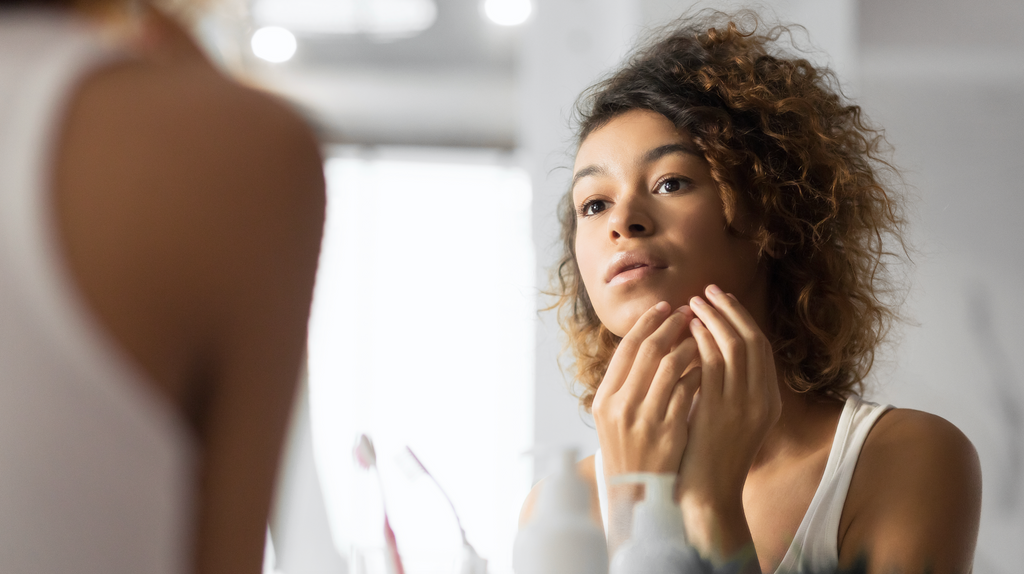Unless you’ve been going hard for that “quarantine glow-up,” your day-to-day look probably sounds more like a Drake song: sweatpants, hair tied, chilling with no makeup on.Factor in that most beauty establishments being closed and you've also got hair that desperately needs a trim, enough leg hair to make a sweater and eyebrows that are not on fleek.
Sound familiar? If so, you might be tempted to go the DIY route for beauty treatments and try to #WellnessFromHome. While it might save you money and temporarily cure boredom, there are some things you should be aware of. Below, we explore these further by tapping experts for their insights on which beauty routines to avoid from your abode.

Beauty Treatments You Shouldn’t Try At Home
1. Dermaplaning and Roller Microneedling
A general rule of thumb, says Dr. Konstantin Vasyukevich, a double board-certified cosmetic surgeon based in Manhattan, is that you should never perform any at-home cosmetic treatments that would require professional help. Attempting dermaplaning or roller microneedling certainly applies. While a quick YouTube search will give you tutorials, this isn’t sufficient enough: “Skin infection, scarring or bad skin cuts might result from incorrectly performed microneedling or dermaplaning,” says Dr. Vasyukevich.
Since the skin is being punctured, proper sanitation also comes into question. “In order to safely perform these treatments at home, one should have a thorough knowledge of proper sterilization techniques and be quite proficient with manipulating the roller or a blade,” he adds.

2. Chemical Peels
If you want a spa day at home, stick to the candles, magazines and facemasks. Things like skin resurfacing and chemical peels should be left to the pros. “Although, mild chemical peels can be a great way to keep your skin looking smooth and healthy, increasing the strength of the peel might result in skin burns, scarring and unsightly pigmentation,” explains Dr. Vasyukevich. In addition to the risk of skin infections and keloids, these same issues can stem from any kind of at-home dermabrasion treatment.
If there’s one thing you can feel free to add to your at-home spa day, it’s the new Feeling Zen™ from Vital Proteins®. Feeling Zen™ capsules contain an array of functional ingredients, including organic ashwagandha root extract, magnesium and GABA. L-Theanine is also added to help promote an “alert calm” for the ultimate “deep breaths” remedy.**
3. Lash Lifts
Eyelash extensions falling out left and right? This can be super disheartening, but not reason enough to try any major lash extension treatments by yourself.
“People should definitely not try a lash lift at home because you're working with a glue, a hair relaxant and other chemicals right next to the eye,” says Amber Budd Peterson, licensed advanced practice esthetician and founder of Amber Budd Skincare and MyEsthi app. “It's impossible to get a good clean curl on a closed eye, on yourself, without the potential to burn your eyeball with the chemicals.”
Unless you’re able to see a professional, stick to these other tried-and-true forms of eyelash extensions. This includes false eyelashes, mascara or an eyelash curler.

4. Waxing
When it comes to waxing and hair removal in general, the technique is everything. It’s the difference between loving your results, the amount of time spent, and whether you’re left in Steve-Carrell-in-The-40-Year-Old-Virgin-waxing-scene level pain.
“One wrong move can lead to bleeding, ingrown hairs or painful scarring,” Adina Mahalli, a hair and skincare expert for Maple Holistics, explains to Lively. “Even an experienced waxing technician shouldn't wax themselves. Proper waxing requires precise skin stretching and applying to tough to reach areas that should not be attempted alone.”
5. Laser Hair Removal
Speaking of hair removal, you might be tempted to purchase your own at-home laser hair removal machine. Yet, according to NYC-based dermatologist, Dr. Hadley King, these at-home devices are similar to the ones you would see in a professional setting. The major difference is that the lasers have a lower energy setting.
The downside is that if you’re not careful enough, you could burn yourself. “Treating an area twice, for example, won't give you faster results,” she says. This is why it’s so important to read the instructions carefully or just steer clear of it altogether.

6. Extracting Pimples or Blackheads
“While it may be tempting, extracting at-home can lead to many problems including irritation, inflammation, scarring, capillary damage and worsening the breakout,” says Josie Holmes, Esthetician at SKINNEY Medspa.
The same goes for extracting blackheads, adds Dr. King. “Squeezing blackheads can traumatize the skin, introduce bacteria and damage the pore, which can spread debris and bacteria deeper into the tissue. This is the risk for inflammation, infection and scarring increase.”
Instead of squeezing, you could use a comedones extractor, which is a small loop on the end of a metal rod. “Unlike squeezing, the comedones extractor does not compress the sides of the pore, so there is less risk of breaking the pore walls,” Dr. King says. “However, tissue damage may still occur so it's important to be very careful if you're attempting this at home.”
If you’re someone who's used to pore strips, there’s some good news and bad news. While they will temporarily remove the blackheads, Dr. King says that it won’t do anything to prevent them from happening again. Additionally, “the adhesive can cause irritation or traumatize the skin.” As with any beauty treatment, be sure to use carefully and follow instructions.













